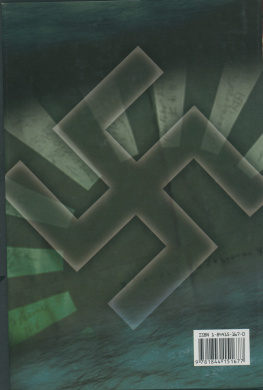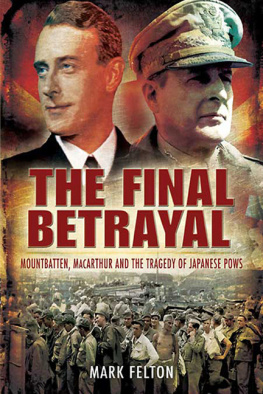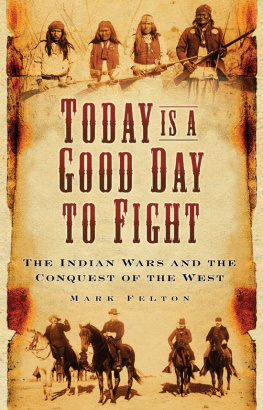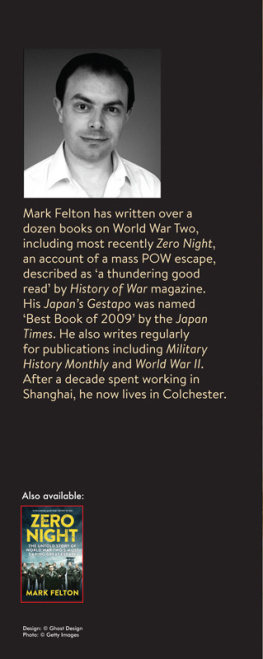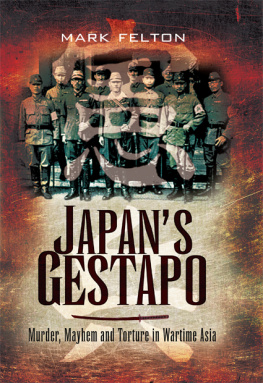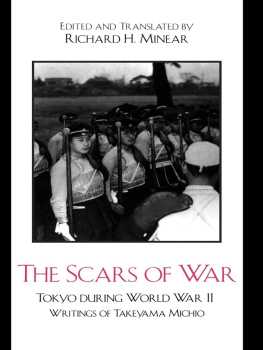For my son William,
without whom this book would have been
written much more quickly

First published in Great Britain in 2009 by
Pen & Sword Military
an imprint of
Pen & Sword Books Ltd
47 Church Street
Barnsley
South Yorkshire
S70 2AS
Copyright Mark Felton, 2009
ISBN: 978-1-84415-912-3
ePub ISBN: 9781844684441
PRC ISBN: 9781844684458
The right of Mark Felton to be identified as Author of this Work
has been asserted by him in accordance with the Copyright,
Designs and Patents Act 1988.
A CIP catalogue record for this book is
available from the British Library.
All rights reserved. No part of this book may be reproduced or transmitted
in any form or by any means, electronic or mechanical including
photocopying, recording or by any information storage and retrieval
system, without permission from the Publisher in writing.
Typeset in 11/13pt Sabon by
Concept, Huddersfield, West Yorkshire
Printed and bound in England by
CPI UK
Pen & Sword Books Ltd incorporates the Imprints of Pen & Sword
Aviation, Pen & Sword Maritime, Pen & Sword Military, Wharncliffe
Local History, Pen & Sword Select, Pen & Sword Military Classics,
Leo Cooper, Remember When, Seaforth Publishing and
Frontline Publishing.
For a complete list of Pen & Sword titles please contact
PEN & SWORD BOOKS LIMITED
47 Church Street, Barnsley, South Yorkshire, S70 2AS, England
www.pen-and-sword.co.uk
Contents
Acknowledgements
A great debt of thanks to the great team at Pen and Sword Books, particularly to Brigadier Henry Wilson, my editor Bobby Gainher, my copy editor George Chamier and to Jonathan Wright and Jon Wilkinson for all of their hard work. My thanks to Jill Durney, of the Macmillan Brown Library, University of Canterbury in New Zealand for the hours spent rooting through the dusty archives and disintegrating records of the International Military Tribunal for the Far East. Thanks to David Parker, OBE, Director of Information and Secretariat at the Commonwealth War Graves Commission regarding information on civilian internees in Shanghai. A great many thanks to Ron Taylor and the wonderful members of the Far East Prisoners of War Association (FEPOW) who have been such an important source of information. I should also like to extend my thanks to Hap Halloran for relating his experiences of being shot down over Japan and held prisoner by the Kempeitai, and to Shirley Felton for her bibliographical research. Many thanks to the Photograph Archive at the Imperial War Museum in London, and the staff at the National Archives (Public Record Office) at Kew, and at the Australian War Memorial, Canberra. Finally, I thank my wife Fang Fang for her support and encouragement of my writing, and her love.
Introduction
This book is not for the fainthearted or easily disgusted. What follows through these pages is a glimpse into the dark heart of humanity. It is a catalogue of Man at his very worst. Recounted in these chapters are examples of hair-raising brutality that raised the bar of depravity at a time when the whole world seemed to have gone mad, when nations clashed and the little person counted for very little. Blood almost drips from the pages, and the screams of the long dead echo down the decades to us now in the security and comfort of the twenty-first century.
The villains at the centre of this book are Japans wartime military police, a vast and nefarious organization called the Kempeitai, or Corps of Law Soldiers. This book is by no means the definitive story of this depraved and hateful organization, but rather provides a glimpse of the myriad activities that the Kempeitai was intimately involved in all over occupied Asia. The crimes of the Kempeitai rival those of Germanys Gestapo in their breadth and savagery, and in many cases the Kempeitai went much further down the path of pure evil.
I live in a city where the Kempeitai once ruled with a will of iron. In Shanghai today there are many buildings still in existence that once were important parts of the Kempeitai empire. There are no plaques recording this dark history as one might expect in Berlin or Singapore, but nonetheless these rather nondescript and down-at-heel buildings that now huddle together with other old structures as the city around them rises into the sky in the form of glittering glass skyscrapers still have the aura of hate about them. North of the Bund, the famous Million Dollar Skyline of 1930s Shanghai, is Suzhou Creek, and across the famous Garden Bridge is an area of buildings that in its heyday was a very upmarket area of the city but today is rather forlorn. Close to the river stands a large white 1930s apartment building called Bridge House. This was the main torture centre for the Kempeitai during the Second World War, where, as you will see as you read on, terrible things were done to Chinese and Western nationals inside its basements and converted apartments. In its courtyard the crackle of rifle fire was often heard reverberating off the walls as firing squads daily dispatched the broken and bleeding victims of Japans mad experiment with empire.
If any building is full of restless spirits in Shanghai today it should be Bridge House, a true house of the dead. Today families live inside this place of sadism and murder, ignorant of the buildings bloody past. No one lives in the Lubjanka in Moscow or at Gestapo headquarters at Prinz Albrecht Strasse in Berlin today, but in Shanghai history has a way of slipping into obscurity, and the sins of the past are easily expunged from the present. Bridge House is in many ways a fitting memorial to the Kempeitai, because like Bridge House most of these murderers escaped retribution after the war was over and most managed to metamorphose into something harmless and low-key in the post-war world.
The Kempeitai was the product of Japans hysterical hatred, mistrust and fear of the West. It was also a reflection of the vast inferiority complex many Japanese retained about the Western Powers and their intentions towards Japan. The Kempeitai was the culmination of all these complicated feelings and political theories, and an expression of Japans belief in the innate superiority of the Sacred Islands and the ideologies that propped up Japans imperial ambitions. Millions died at the hands of the Kempeitai, but who in the world has ever heard of this organization? Like the war in Asia itself, the Kempeitai have become just a footnote to history, known only to academics and historians. Even the Japanese know little of its crimes, or the extent of its brutality. Read on and be disgusted, because that is how we should feel. And until Japan apologizes for her wartime record, we should keep reminding them of how disgusted we still are.
Shanghai
November 2008
Chapter One
Big Brother
The Emperor is a Revealed God among men, a Manifest Deity for us.
State Shinto belief, Japan
A man sat in a wooden chair with his head resting on his chest. Blood dripped from his mouth and chin. His hair was long and dirty and hung across his eyes like a veil. He was stripped to the waist, his torso oily with sweat. The man groaned and slowly raised his head to look at his inquisitors. There were two of them. One sat before the man on a chair, wearing an army shirt, breeches and riding boots, his sleeves rolled up, a cigarette in his right hand. The second, dressed similarly to the seated man, stood in the shadows, for the room was small and airless, holding a thick wooden club in his hands. The man tied to the chair moaned again and muttered something in English. The seated inquisitor leaned forward and cocked his ear towards the Englishmans lips, listening intently. Suddenly he jumped up and yelled, Liar! You lie to me again? You think that we do not already know the truth? His accent was heavy, and he turned to his comrade and grunted an order in Japanese. The man with the club stepped forward and with a sharp intake of breath he brought the club down on to the Englishmans exposed back again and again, the blows raining down with rhythmic regularity, the strokes well-practised many times over in this dark, dank room. The Englishman screamed as the wood bit into his flesh, and he twisted and fought like a trapped animal, but his bindings were strong and held him firmly pinned to the chair which was itself bolted securely into the grimy floor. Twenty blows later it stopped. The Englishman moaned and groaned while his Japanese torturer leaned forward to ask the same questions over and over again, as he had asked for several preceding days to obtain the confession he searched for. When the answers failed to satisfy, the Japanese pushed his lit cigarette into the Englishmans face, mashing the hot ash into the skin until the pungent smell of burned flesh filled the room. Then the beating began again. This was a vignette of horror repeated tens of thousands of times throughout the Occupied Territories of Asia during the Second World War, committed by an organization so unscrupulous, savage and obedient to Japans war aims that torture and abuse were its stock in trade.


